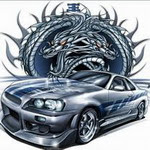

Most powerful racing 911 considerably improved
The Porsche GT3 RSR launches into the new model year with extensive modifications. The most powerful race car based on the Porsche 911, which last year scored wins at the 24 hour races of Le Mans and Spa as well as overall victory at the Nuerburgring 24 hours, competes in the GT2 class at international long distance races. The most distinguishing feature of the new GT3 RSR is the front end which received major improvements to the aerodynamics. The majority of innovations however are hidden under the weight-optimised body.
Aside from the easily recognisable additional spoilers on the front apron, so-called flicks, an optimised air ducting with newly-designed side air outlets generates more downforce and reduces drag. The rear end including the rear wing was taken over from the predecessor. Extensive changes to the suspension cinematics increase mechanical grip considerably. The range of possible suspension set-ups was broadened.
The 3.8-litre boxer engine of the GT3 RSR remains unchanged apart from slight improvements to details. It delivers 465 hp (342 kW) at 8,000 revs per minute and delivers a maximum torque of 430 Nm at 7,250 revs. The rev limiter of the efficient six-cylinder kicks in at 9,400 rpm.
Much of the know-how in the GT3 RSR’s totally new gearbox has come from the RS Spyder sports prototype. The sequential six-speed unit, developed by Porsche engineers, is considerably lighter than its predecessor. Internal friction was substantially reduced. The flat angle of the drive shafts allows teams a wider range of suspension set-ups.
Aside from the GT3 Cup and the GT3 Cup S, the GT3 RSR is the third race car based on the Porsche 911 offered by Porsche Motorsport. Thirty-five units of the fastest and most powerful long distance racer made in Weissach, apart from the exclusive RS Spyder sports prototype, are now being produced and delivered to customer teams around the globe. The price of the GT3 RSR is 349,800 Euro plus VAT.
Engine
Six-cylinder aluminium boxer engine, water-cooled; 3,795 cc; stroke 76.4 mm; bore 102.7 mm; 465 bhp (342 kW) at 8,000 rpm; max. torque 430 Nm at 7,250 rpm; air restrictors 2 x 29.5 mm; maximum engine speed 9,400 rpm; four valves per cylinder; dry sump lubrication; individual throttle butterflies; central air intake; electronic MS 4.0 engine management; fuel injection; fuel grade: RON 98 Super Plus unleaded.
Power transmission
Six-speed gearbox with sequential jaw-type shift; oil/water heat exchanger; single-mass flywheel; hydraulic disengagement lever; three-plate carbon-fibre clutch; rear wheel drive; limited-slip differential 45/65 %.
Body
Monocoque body (basis GT3 RS) of hot-galvanised steel; aerodynamically optimised front end with front spoiler; aerodynamically optimised front underfloor; adjustable rear wing; 90-litre safety fuel tank with fast filling function; air jack; welded-in safety cage; bucket-type racing seat (on driver's side only) with flame-resistant seat cover; six-point seat belt adapted for use of the HANS Head and Neck Support; electric fire-extinguishing system.
Suspension
Front: McPherson spring strut axle; Sachs four-way gas pressure dampers; double coil springs (main and ancillary spring); front axle arms adjustable for camber; adjustable sword-type anti-roll bar on both sides; power steering.
Rear: Multi-arm axle with rigidly mounted axle sub-frame; Sachs four-way gas pressure dampers; double coil springs (main and auxiliary spring); rear axle tie-bar reinforced and infinitely adjustable; adjustable sword-type anti-roll bar on both sides.
Complete suspension infinitely adjustable (height, camber, track).
Brakes
Brake system with balance bar control.
Front: Single-piece six-piston aluminium fixed callipers; inner-vented, 380 mm in diameter; racing brake pads.
Rear: Single-piece four-piston aluminium fixed callipers; inner-vented, 355 mm in diameter; racing brake pads.
Electrical System
Motec display with integrated data recording; adjustable traction control; battery: 12 volt, 50 Ah, 140 Ah alternator.
Wheels
Front: Three-piece BBS light-alloy wheels (11J x 18-34); central bolt;
Rear: Three-piece BBS light-alloy wheels (13J x 18-12.5); central bolt.
Weight
Approx. 1,225 kg complying with A.C.O. regulations, 1,200 kg complying with FIA regulations.








No comments:
Post a Comment